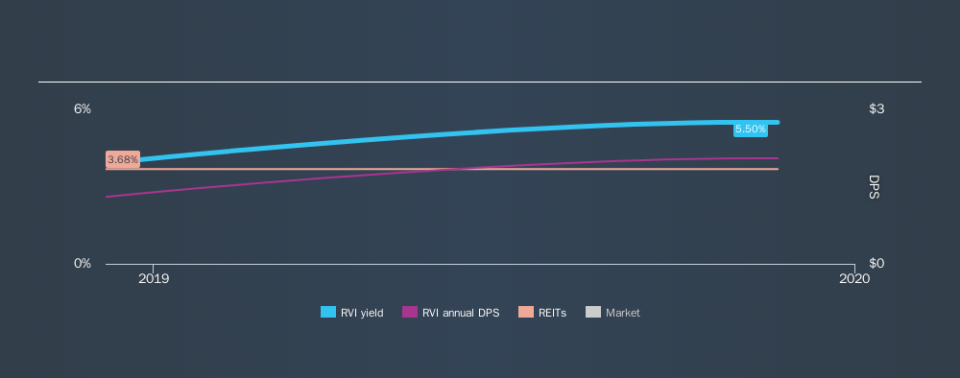Retail Value Inc. (NYSE:RVI) Looks Like A Good Stock, And It's Going Ex-Dividend Soon

Retail Value Inc. (NYSE:RVI) stock is about to trade ex-dividend in 2 days time. Investors can purchase shares before the 25th of November in order to be eligible for this dividend, which will be paid on the 8th of January.
Retail Value's upcoming dividend is US$2.05 a share, following on from the last 12 months, when the company distributed a total of US$2.05 per share to shareholders. Based on the last year's worth of payments, Retail Value stock has a trailing yield of around 5.5% on the current share price of $37.31. Dividends are an important source of income to many shareholders, but the health of the business is crucial to maintaining those dividends. That's why we should always check whether the dividend payments appear sustainable, and if the company is growing.
See our latest analysis for Retail Value
If a company pays out more in dividends than it earned, then the dividend might become unsustainable - hardly an ideal situation. Retail Value has a low and conservative payout ratio of just 4.5% of its income after tax. That said, REITs are often required by law to distribute all of their earnings, and it's not unusual to see a REIT with a payout ratio around 100%. We wouldn't read too much into this. Yet cash flow is typically more important than profit for assessing dividend sustainability, so we should always check if the company generated enough cash to afford its dividend. Luckily it paid out just 7.4% of its free cash flow last year.
It's encouraging to see that the dividend is covered by both profit and cash flow. This generally suggests the dividend is sustainable, as long as earnings don't drop precipitously.
Click here to see how much of its profit Retail Value paid out over the last 12 months.
Have Earnings And Dividends Been Growing?
Companies that aren't growing their earnings can still be valuable, but it is even more important to assess the sustainability of the dividend if it looks like the company will struggle to grow. If earnings decline and the company is forced to cut its dividend, investors could watch the value of their investment go up in smoke.
Given that Retail Value has only been paying a dividend for a year, there's not much of a past history to draw insight from.
Final Takeaway
Should investors buy Retail Value for the upcoming dividend? Earnings per share have been flat over this time, but we're intrigued to see that Retail Value is paying out less than half its earnings and cash flow as dividends. This is interesting for a few reasons, as it suggests management may be reinvesting heavily in the business, but it also provides room to increase the dividend in time. We would prefer to see earnings growing faster, but the best dividend stocks over the long term typically combine strong earnings per share growth with a low payout ratio, and Retail Value is halfway there. It's a promising combination that should mark this company worthy of closer attention.
Curious about whether Retail Value has been able to consistently generate growth? Here's a chart of its historical revenue and earnings growth.
A common investment mistake is buying the first interesting stock you see. Here you can find a list of promising dividend stocks with a greater than 2% yield and an upcoming dividend.
If you spot an error that warrants correction, please contact the editor at editorial-team@simplywallst.com. This article by Simply Wall St is general in nature. It does not constitute a recommendation to buy or sell any stock, and does not take account of your objectives, or your financial situation. Simply Wall St has no position in the stocks mentioned.
We aim to bring you long-term focused research analysis driven by fundamental data. Note that our analysis may not factor in the latest price-sensitive company announcements or qualitative material. Thank you for reading.

 Yahoo Finance
Yahoo Finance 
